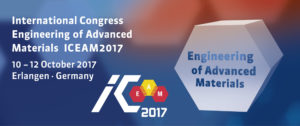ICEAM2017

International Congress Engineering of Advanced Materials ICEAM2017
10 – 12 October 2017, Erlangen, Germany
The Cluster of Excellence Engineering of Advanced Materials (EAM) is pleased to announce that abstract submission and registration are open
for the International Congress Engineering of Advanced Materials ICEAM2017, which will be held in Erlangen (Germany) from 10 – 12 October 2017.
Abstract Submission: www.iceam2017.fau.de/abstracts/
Registration: www.iceam2017.fau.de/registration/
Purpose and topics
The aim of ICEAM2017 is to place 10 years of interdisciplinary research at EAM in the international context of state-of-the-art science and
engineering research. With a mix of invited plenary, keynote and submitted talks and posters, the congress will focus on EAM’s four application
fields, closely interlinked with EAM’s three cross-sectional topics.
Congress topics:
- Nanoelectronic Materials
- Photonic and Optical Materials
- Catalytic Materials
- Lightweight Materials
- Functional Particle Systems
- Nanoanalysis and Microscopy
- Multiscale Modeling and Simulation
Confirmed plenary speakers
- Prof. Cynthia Friend, Harvard University
- Prof. Paolo Samori, Université de Strasbourg & CNRS
- Prof. Andreas Schreyer, European Spallation Source ESS ERIC
- Prof. Ole Sigmund, Technical University of Denmark
- Prof. Andreas Stein, University of Minnesota
In connection with ICEAM2017 the International GRK 1896 Satellite Symposium “In Situ Microscopy with Electrons, X-rays and Scanning Probes”
will take place on 9 October 2017.
Please note the following deadlines
30 April 2017 Abstract Submission
31 July 2017 Participant Registration
Registration Fees
Academia 200 €
Industry 450 €
Updates will be regularly posted on the congress website www.iceam2017.fau.de.
We are looking forward to welcoming you in Erlangen in October 2017!
Best regards,
Your ICEAM2017 Congress Office
Cluster of Excellence Engineering of Advanced Materials (EAM)
Friedrich-Alexander-Universität Erlangen-Nürnberg (FAU)
Nägelsbachstraße 49b, 91052 Erlangen, Germany
Phone: +49 9131 85-20846
Fax: +49 9131 85-20860
E-Mail: eam-ic2017@fau.de
+++++ Deadline Abstract Submission 30 April 2017 ++++